At Your Boxes:
During the next few months you are going to see lots of songbird behaviors performed by our representative songbird, the Tree Swallow.
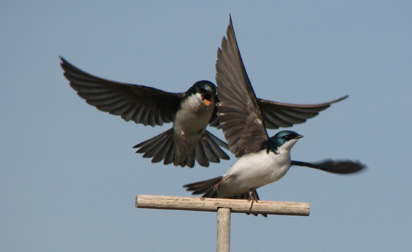
Watching and trying to decipher the meaning of Tree Swallow behaviors is one of the most challenging yet fun things you can do at your project. You’re going to see Tree Swallows behaving in groups and as individuals. You’ll observe male behaviors and female behaviors. You’ll observe them behaving as parents, as dependent young, and as independent juveniles. You’re going to witness behaviors of self-maintenance and preservation. You’ll watch the sum of the behaviors the swallows use to perform the most vital function of their lives, reproducing; passing on their genes to descendants. You’ll want to understand these behaviors, so it’s worth taking a few minutes now to consider some aspects of songbird behavior.
But first a word of advice: please be patient! You will become confused and perhaps even bewildered by what you see and hear at times, but don’t give up. If you persist you’ll start to notice regularities in your birds’ behaviors. Gradually, coherent patterns and themes will emerge. And although there will still be some gaps, you’ll begin to develop a real sense of the whats and whys of your swallows’ actions.
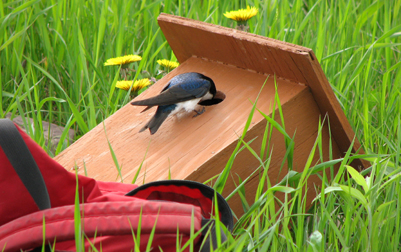
Concepts:
Most Tree Swallow behaviors are reaction to things.
Events or situations in a bird’s environment trigger chains of reactions, and specific cues cause specific reactions.
- A bird’s sense organs, usually its eyes or ears, perceive something it is programmed to note as significant.
- A signal passes from the sense organs along nerves to the bird’s brain.
- The brain then sends a responding signal back out along nerves to specific muscles, which then perform a particular action.
- These sequences are usually fast and automatic. A bird doesn’t have to stop and think about what to do. It doesn’t need to plan, or to reason because it has a set of genetically-programmed responses that fire instinctively.
- These reactive behaviors are performed mechanically whenever their particular activating stimuli are strong enough when the bird notices them. The male swallow above responded automatically when it saw the entrance to a cavity, even though it was on the ground.
- Every songbird species possesses a set of its species’ instinctive behaviors, which let it follow the species’ way of life. A bluebird has the bluebird set; a cardinal has the cardinal set, etc.
- However, it’s wrong to think of songbirds as completely rigid robots. Birds face constantly changing circumstances and must make many choices each day. They must have at least a small level of flexibility for decision making in their responses.
But aren’t songbirds capable of learning?
- Learning is a process which an individual animal can use to change its behavior. It’s especially valuable when the animal must adapt to rapid changes in its circumstances or in its environment.
- For instance, a bird must learn where food is located, or learn to distinguish its mate from among many other individuals.
- Learning can also refine the details of instinctive behaviors, making the instincts more effective.
- But remember that songbird lives are short. There isn’t much time for learning, and most responses to things must be immediate and automatic. Therefore, its ability to survive and reproduce relies primarily on its set of instinctive behaviors.
- However, more than 40 years of watching Tree Swallow behaviors has convinced us that these birds most certainly are capable of learning from experiences and utilizing this in decision making.
As you watch your swallows try to determine the parts of their behaviors. Ask yourself, what is the behavior’s:
- Stimulus: What was the specific cue in the bird’s environment that caused it to react.
- Response: What was the particular behavioral reaction that was activated or released after the bird sensed the stimulus.
- Result: How did the situation change, if at all, for the bird and/or its surroundings after the response was performed. Has the behavior helped the swallow survive or maintain itself in some way? Did it help the bird in its striving to reproduce?
- Photo below by Steve Byland.
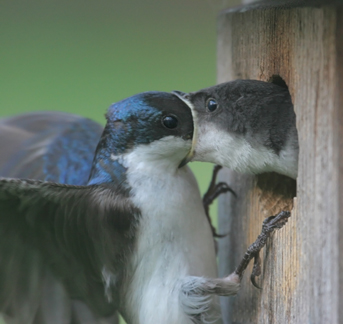
We can observe the “what” of Tree Swallow behaviors, the physical motions or actions. However, often we can only guess about the “why,” the reason a bird performs a given behavior.
- Some behaviors appear clear-cut, with seemingly obvious chains of stimulus, response, and result.
- Others will be more puzzling, but don’t give up trying to figure what’s going on. Perhaps you simply need to see more repetitions of the behavior before you have a “eureka moment.”
- With some behaviors the “why” stays shrouded in mystery. For instance, we don’t believe Tree Swallow “flutter flight” (you’ll see it) has been satisfactorily explained by the experts, yet.
- We have to accept that birds perceive the world differently than we do. Their needs, abilities, and limitations are different from ours. We may not be able to detect the stimuli they are reacting to. And some reactions are so subtle we aren’t even aware behavior is occurring.
- We also must avoid being “anthropomorphic,” meaning we can’t interpret an animal’s behavior in terms of human emotions and motives. Tree Swallows aren’t being “playful,” “angry,” “loving,” “mean,” etc. Songbird behaviors shown by Tree Swallows are things the birds do in the context of swallow survival and reproduction, not human.
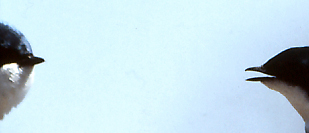
It may help to distinguish between Maintenance Behaviors and Social Behaviors.
- Maintenance behaviors; such as foraging, preening, and reacting to potential danger or inclement weather. Individual birds perform these to care for their own bodies and avoid injury or death.
- Social behaviors; such as those involved in courtship, territoriality, raising young, and flocking involve interactions among birds. These types of behavior use sounds, postures and movements as signals conveying specific “messages” to influence the behavior of others. Social signals of birds are not the same as human spoken language. They are more like the “body language,” we produce unconsciously, which is probably a truer indicator of our feelings and motives than our speech.
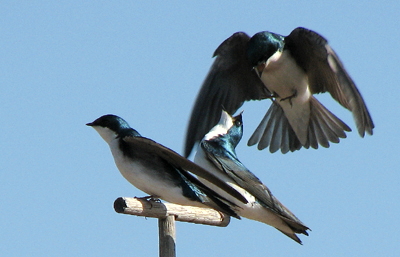
We can also distinguish between Immediate Causes and Ultimate Causes of behavior.
- Immediate Causes, (also called Proximate causes), are those stimuli in an individual bird’s present environment that release a given behavior.
- Ultimate Causes are reasons found in a species’ long-term history. They are why particular behaviors are part of the genetically-fixed response patterns every member of the species possesses.
As the nesting season progresses through its series of stages you should notice major shifts in Tree Swallow behaviors.
- Nesting season behaviors are often due to changes in a bird’s “internal state.” Hormone level shifts during the breeding stages affect which stimuli a bird notices or seeks out, and what response they make.
- Some behaviors occur throughout the nesting season, but become either more or less frequent over time.
- Other behaviors correspond to particular nesting stages, and are seldom or never seen at other times.
Be aware that while each songbird species has a set of typical behaviors, individuals’ performances can vary considerably.
- If you have several pairs of Tree Swallows nesting relatively near each other in a grid, you’re lucky. You can compare songbird behavior shown by Tree Swallows more easily than with most other songbird species.
- Expect to see variation in when, how long, how often, and how vigorously different birds execute particular behaviors.
- The more you watch the more you’ll discover your swallows truly are unique individuals.
Also be aware that songbird behavior shown by male and female Tree Swallows may be different.
- The sexes’ different roles in reproduction demand a somewhat different set of reproductive behaviors.
- Males and females may have different “agendas” or “motivations.” The behaviors that result can even conflict with those of their nesting partner at times. These acts don’t involve conscious planning or forethought of course; they’re strictly instinctive.
- The sexes may also respond in different ways or degrees to the same stimulus.
- You may learn to distinguish the sex of some adult songbirds by their behavior alone.
- And, nestlings and juveniles like the ones below have their own sets of age-specific behaviors.
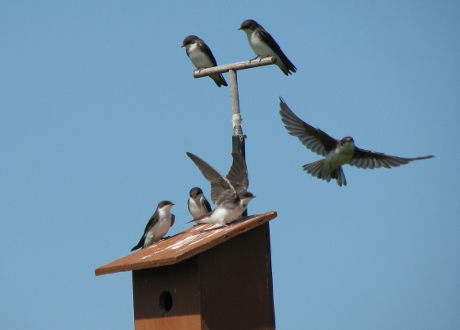
All this may seen mind-boggling at first. But don’t let that discourage you from getting out there and watching your swallows. Remember, much of what you’ll gain depends on the amount of time and effort you spend in the field observing swallow behavior and all the other things that are going on.
And if you’re really enthused and want to explore bird behavior in depth, a great aid is the Handbook of Bird Biology, produced by The Cornell Laboratory of Ornithology.
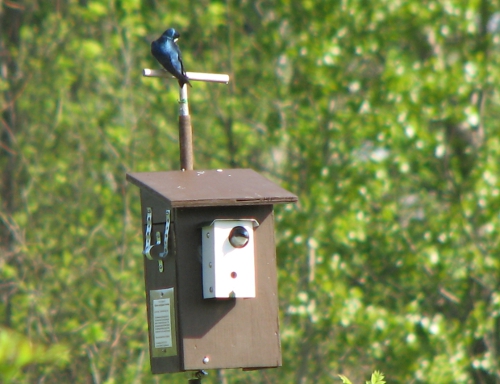
Question for the next topic: Tree Swallow Song and Calls.
- What is the purpose of the various sounds birds make?
——————————————————————————–
Home: Tree Swallow Nest Box Projects
Creating Tree Swallow Nest Box Projects
Spring Return
Nesting Season Behavior
Song and Calls
Nest Site Claiming
Pair Formation
Nest Building
Bird Flight
Mating and Paternity
Diary of One Season at Salmon Creek
Monitoring Nest Boxes and Keeping Records
Making Box Checks Keeping Box Records Control Sheets Season Summaries Print Sheets
Banding Your Tree Swallows Banding Adults Banding Nestlings
Tree Swallows in Research Research Bibliography Glossary of Terms